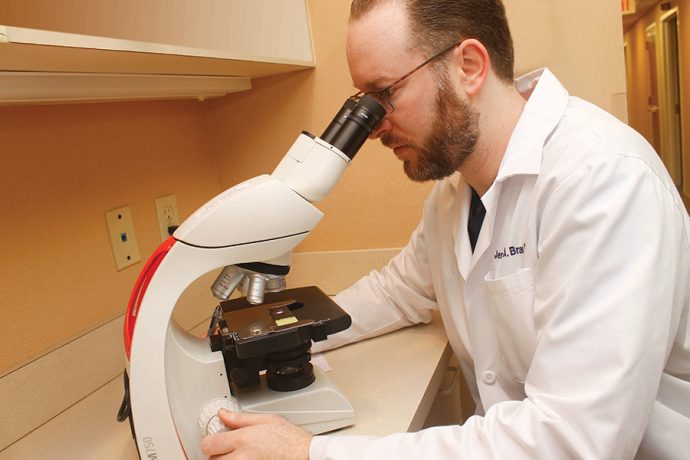All men may be created equal, in the words of The Declaration of Independence. But all skin cancers aren’t, says Jeremy A. Brauer, MD, a dermatologist with practices in Rye and Manhattan.
While basal cell and squamous cell are the most common forms, “melanoma is the one we’re most concerned about,” he says. Nonmelanoma skin cancers appear mostly on the head, neck and extremities; melanoma, on the back in men and on the legs in women.
“All three have a component of sun exposure, although there are also genetic factors,” Brauer adds. “Surgery has the highest cure rate. But not everyone may be a good candidate for surgery. And not every skin cancer may meet the appropriate-use criteria for surgery.”
Fortunately, most basal- and squamous-cell cancers are slow-growing and can be successfully treated with electrodessication and curettage to burn off and scrape the tumors, standard surgical excision or topicals and radiation therapy. However, there are certain tumor subtypes and locations as well as patient characteristics that may require the Mohs micrographic surgical technique, in which Brauer did a two-year fellowship at the Laser & Skin Surgery Center of New York. Named for Frederic E. Mohs, the physician and surgeon who pioneered the surgery in the 1930s, Mohs is an efficient if time-consuming procedure in which the tumor is removed and studied under a slide, layer by layer, while the patient waits. After the surgeon maintains “clear margins,” the wound is repaired. Mohs not only has the highest cure rate, it also saves the greatest amount of healthy tissue and leaves the smallest scars.
While some surgeons have begun to use Mohs in the treatment of melanoma, Brauer says, the standard of care is still wide surgical excision.
As for any resulting scarring, he says there are surgical and nonsurgical techniques to improve the skin’s appearance and texture, including lasers, steroid injections and fillers.
When it comes to skin cancer, he says, “a lot of what we see today is the result of past behaviors.” Yesterday’s sun worship is the serious skin damage of today and tomorrow. And it’s not just an excessive love of Mr. Sun.
“Unfortunately, skin cancer is on the rise for younger patients,” Brauer says. This may be due in part to the popularity of tanning beds, “although fortunately, a lot of states have legal age limits.”
While he says that “most skin cancers are curable,” the old saying about an ounce of prevention being worth a pound of cure applies. “The use of FDA-approved UVA, UVB broad-spectrum sunscreen is a must,” he adds. “The SPF (sun protection factor) number matters, but it’s only half the story. Use one with a minimum number of 30. Beyond that, the benefits are incremental.”
The other half of the story is applying the sunscreen as directed, and wearing UPF (ultraviolet protection factor) hats and clothing. (Brauer says he is particularly mindful of this when he, his wife – Anate Brauer, a doctor specializing in reproductive endocrinology and infertility in Tuckahoe and Greenwich – and their three young girls go swimming and biking.)
The Mamaroneck resident, whose amiable bedside manner has made him a quotable doc on everything from Buzzfeed to Reader’s Digest, has always loved working with children. Growing up on Long Island, he first thought about being a pediatrician. But at the University of Pennsylvania’s Perelman School of Medicine – which he attended after graduating “with highest distinction” from Cornell University – he was struck by the versatility of dermatology, a discipline that has cosmetic and reconstructive components.
“Luckily I never have the same day twice,” he says. “I love what I do.”
For more, visit jeremyabrauermd.com.





